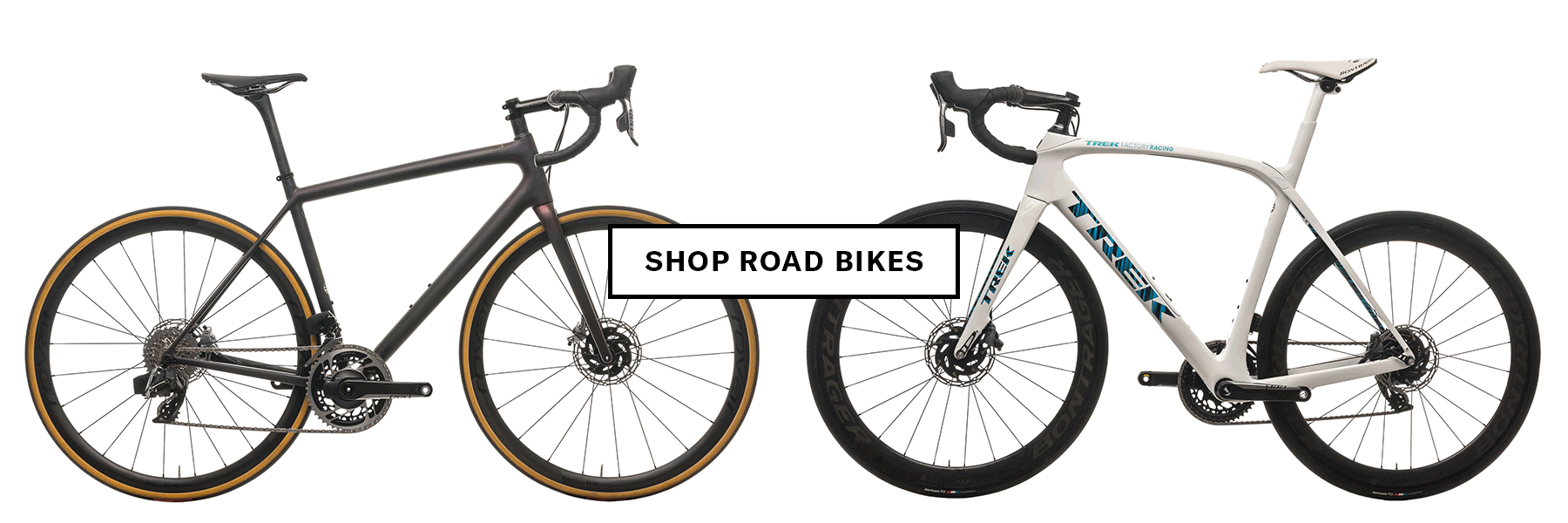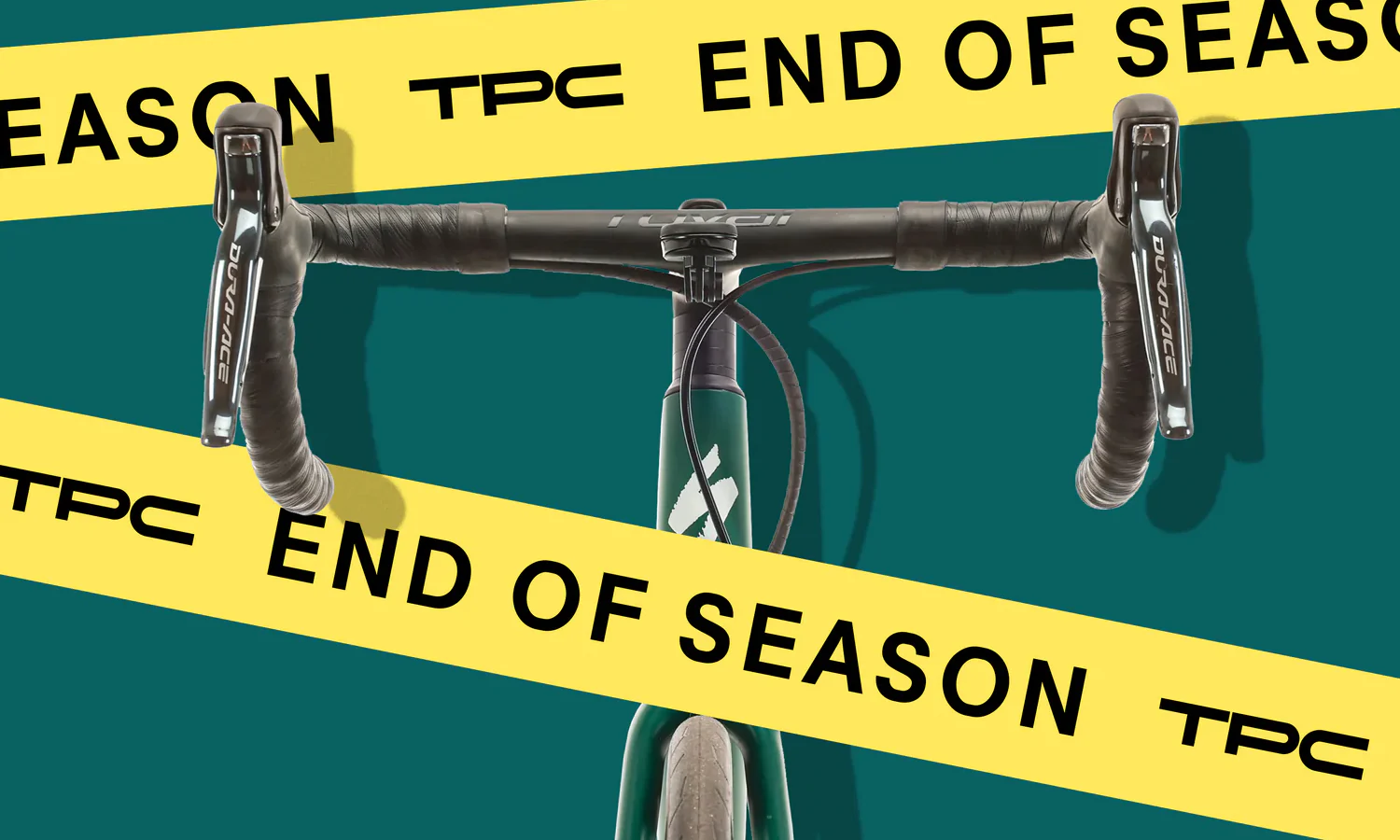Like cyclists, road bikes come in all shapes and sizes. You’ll find nimble climbers, full-throttle sprinters, and ‘round-town daily drivers. To maximize your riding enjoyment, your bike needs to be the mechanical yin to your physical yang.
If you've been looking for a beginner's guide to road bike sizing, well you've come to the right place.
[button]Shop road bikes[/button]
Why pick a road bike?
Whether you are descending smooth tarmac, exploring backroads less traveled, or simply committing to that one-less-car lifestyle, road bikes are freedom machines. Unlike mountain bikes, which find their sweet spot on twisty singletrack and steep rock gardens, road bikes are born to shine on paved or mixed road surfaces.
Sounds great, right? You want one. But before you dive into your new road bike lifestyle, know that nothing will bring your stoke to a record-scratching halt faster than a bike that’s the wrong size. With no way to “Goldilocks it” when you’re buying online, use this guide to help find a road bike that fits.
Why does road bike size matter?
Not to sound too dramatic, but an ill-fitting bike can become a two-wheeled torture machine. Frame size affects your body position as you ride, and small things (like having to stretch to reach the bars, or poor knee positioning over the pedals), can make the whole experience miserable. Back pain, knee pain, numb hands, and more — all can be caused by imperfect bike size.
To get started on this journey to pain-free riding and maximized fun-time, you’ll need some numbers. Manufacturers will often provide sizing guides online — match your height against a chart and see the suggested size range — so let’s get measuring.
[newsletter]
Finding the measurements you’ll need
Grab a friend (trust us, this makes it easier), and note the numbers you’ll need to help determine your road bike size: height, inseam, and arms.
How to measure your height
First, take off your shoes. Now stand with your back against a wall and your feet shoulder-width apart. Get your friend to lay a ruler lightly on the top of your head, straight back to the wall, and mark it. Now measure from the mark to the floor and note the numbers in total inches or centimeters.
How to measure your inseam
Standover is a word that means what it says — it’s the distance between your crotch and top tube when you “stand over” the bike. If your bike's standover height is too tall, it will feel too big. You might not be able to put a foot down when you come to a stop, and it can cause real a reach ouchie emergency to your … let’s just say undercarriage. For newer riders, it's nice to have at minimum 1" of clearance. To help ensure your standover height will be adequate, you will need your inside leg measurement. You’ll also need a book.
Steps to getting your inseam digits:
1. Just like with height, take off your shoes and stand with your back against the wall, feet 6-8 inches apart
2. Take a book, place the spine between your legs and side it up to meet your crotch. Imagine you’re riding the book. No, you don’t look stupid!
3. Mark the wall where the top of the book touches the wall
4. Measure from that mark to the floor and you have your measurement
How to measure the reach of your arms
Height and inseam measurements will put you in the sizing ballpark, but some will end up in between sizes. If so, prioritize your upper body dimensions, which determine your reach, to decide if you should go up or down a size for the best fit. To calculate reach (how stretched out or cramped you are when you reach for the handlebars), you will need to know what’s called your “Ape Index” measurement. This is the measurement of the ratio of your arm span relative to your height.
How to measure your “Ape Index”
1. Stand against the wall and spread your arms out straight from your shoulders on either side
2. Get your friend to mark the tip of the longest finger of each hand on the wall and measure that distance
3. Take the length of your maximum arm span and subtract your height
4. If the number is positive, choose the larger frame size
5. If the number is negative, choose the smaller frame size
[button]Shop road bikes[/button]
A picture-perfect frame
Head tube angle, reach and stack — these are just a few of the measurements that go toward creating the geometry of your bicycle. Take a deep dive into how bike geometry works here, but in a nutshell, frame geometry affects not just how you fit the bicycle, but ride characteristics, too, such as handling, comfort, and responsiveness.
Because of the nuances of frame angles across the different kinds of road bikes, it pays to look at the numbers and compare bikes against each other in your hunt for your perfect ride.
Bike sizes
Manufacturers typically label bikes sizes on the seat tube or down tube, and in one of two ways: A number in centimeters (typically a classic road bike) or a size letter (gravel/commuter/hybrid/lifestyle bikes). Below is a general guide to show how those numbers correlate when it comes to frame size. Check manufacturer’s websites for specifics as there is not a standard sizing system.
• X-Small: 44-47cm
• Small: 48-51cm
• Medium: 52-55cm
• Large: 56-58cm
• X-Large/59cm+
The difference between men and women’s bike geometry and sizing
Some manufacturers have women’s specific road bikes with different geometries. Along with the women’s specific components you’ll often find on these bikes (narrower handlebars and saddles designed for women’s anatomy, for example), when it comes to the frame itself, the top tube will typically be shorter. Why? On average, women have longer legs and shorter torsos when compared to men of the same height — a shorter top tube results in a reach that will likely fit more women.
In general, women’s specific frames also come in smaller sizes. When determining if you’d benefit from a bike designed with women in mind, follow the same measurement protocols featured in this guide to help make that call.
[button]READ THE WOMEN'S BIKE BUYER'S GUIDE[/button]
Different types of road bikes
Road bikes come in many flavors, each catering to a specific purpose. From epic mountain climbs to city streets to bone-jarring gravel, there’s no shortage of ways to scratch your cycling itch. But it’s not just the desired experience that sets these road bikes apart from each other — it’s geometry. Consider both when choosing your bike.
Road bikes
From weekend warriors to racers throwing down in a crit, these are the bikes you think of when you think Tour de France or full-lycra kit. The geometry of a race or race-inspired road bike will be more aggressive (think steeper frame angles and shorter rear ends) to offer a stiffer, more responsive handling experience as you’re chasing down the breakaway or attacking on a climb.
Examples: Giant TCR, Trek Emonda, Specialized Tarmac, Liv Avail
Aero road
Designed for those who like to maximize their wattage and minimize their wind resistance, this is where geometries and tube shapes can get quite aggressive. An aero-focused road bike’s geometry will put your body into a lower, more stretched-out position to reduce drag. Steeper steering angles, stiffer rear ends for more responsive handling, and aerodynamic tube shapes make these bikes ‘slippery’ in the wind but may sacrifice comfort in the process.
Are aero road bikes actually faster?
Examples: Specialized Venge, Pinarello Dogma, Trek Madone, Cervelo S5, Cannondale SystemSix
Endurance/Sportive bikes
With comfortable riding positions that help you tap out mile-after-mile in relative comfort, endurance or sportive bikes have a more relaxed geometry and greater stack to deliver a more upright ride position which reduces stress on the body. Lower bottom brackets and a longer wheelbase will help to improve stability overall.
Examples: Cannondale Synapse, Specialized Roubaix, Trek Domane, Canyon Endurace, Giant Defy
Why you should ride an endurance road bike.
Gravel bikes
Gravel is the new hotness! Built with geo tweaks such as a more relaxed ride position, lower bottom bracket, and longer wheelbase to improve ride comfort on the rough stuff. Some gravel bikes will also incorporate ride-damping technologies to help smooth bumps and reduce fatigue, and wider tire clearance to fit beefier, gravel-grinding tires to help you take it off-road on your mixed-terrain ride.
Examples: Santa Cruz Stigmata, Canyon Grail, Specialized Diverge, Giant Revolt
[button]Shop gravel bikes[/button]
Commuter/Hybrid bikes
Road bikes with commutes or errands on their minds feature geometries and frame qualities that are versatile. Once again, many will have a more upright ride position to keep you comfortable and have a longer wheelbase to provide a more grounded, stable ride. The frame itself is designed to handle the weight of panniers, racks, and fenders.
Examples: Trek Super Commuter, Spot Brand Acme, Raleigh Sprite
Electric bikes
Our pedal-assist friends are seeping their way into all varieties of road bikes. You’ll find electric bike versions of bikes to commute on, step-through errand runners equipped with panniers and racks, more recreational cruiser-type hybrids, and even high-performance road bikes. Geometries of these bikes are matched to the ride experience and follow similar guidelines as the aforementioned road bike types but have to also take into account the addition of a battery and motor to the frame or rear wheel.
Examples: BMC AlpenChallenge, Trek Domane+, Specialized Turbo Creo
[button]Shop e-bikes[/button]
How bike weight impacts your ride
The lighter your bike, the more efficiently and quicker you’ll climb or accelerate off the line and out of corners. Conversely, while a heavier bike may feel more stable or handle more predictably, it will slow down your rate of acceleration particularly when climbing — it’s a drag, literally.
Putting ride characteristics aside, take the weight of your bike into consideration if you know you’ll be regularly hauling it upstairs for storage, or lifting it in and out of racks (on public transport, for example).
But how much does bike weight really matter? Read our article to find out.
Choosing the right bike size for you
| Measured Frame Size | Frame Size | Min. Rider Height | Max. Rider Height |
| 48cm | XS | 4' 11" | 5' 2" |
| 50cm | Small | 5' 2" | 5' 5" |
| 52cm | Small/M | 5' 5" | 5' 7" |
| 54cm | Medium | 5' 7" | 5' 10" |
| 56cm | Large | 5' 10" | 6' 1" |
| 58cm | Large/XL | 6' 1" | 6' 3" |
| 60cm | XL | 6' 3" | 6' 5" |
Conclusion
Road bikes are super fun smile-making machines, and the best way to guarantee you get that experience is knowing the ins and outs of how to find one that fits. While knowing your measurements and desired ride experience will help narrow down your bike size, a little knowledge of the nuances of frame geometry will also go a long way on this journey to your perfect ride partner. It’s also worth noting that smaller tweaks to fit can be made by adjusting your bike fit with a professional bike fitter, who can help fine-tune your body position on your sweet new ride.
See you on the road.
Our Ride Guides love helping people find the right bike and gear. If you have any questions, give us a call at 1-866-401-9636 and we'll help you out!













